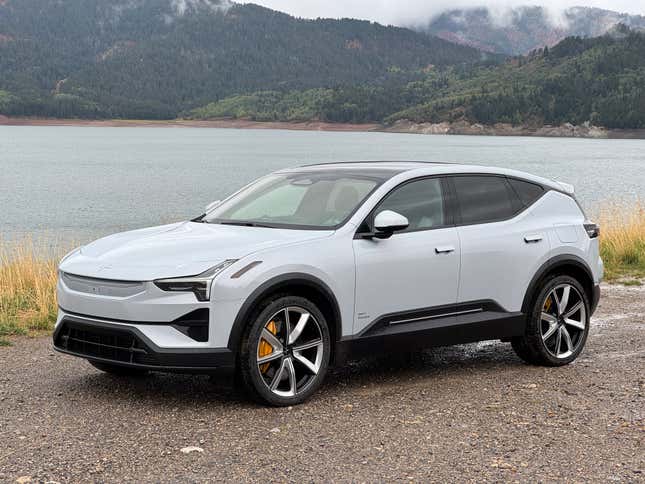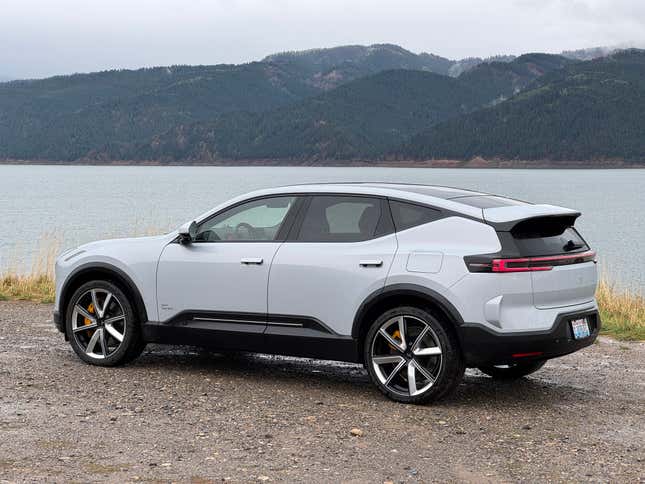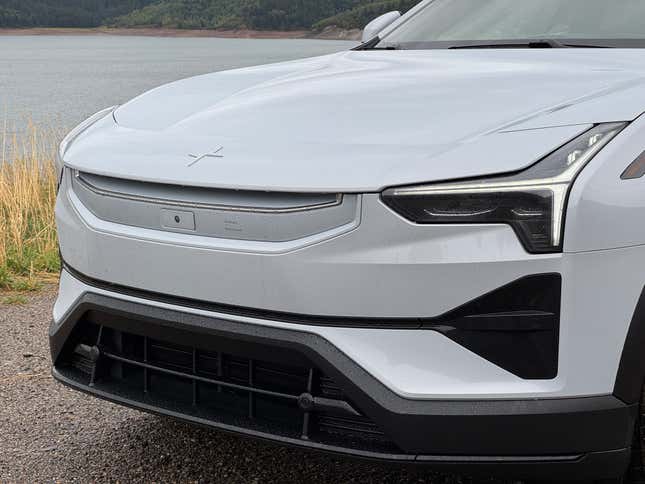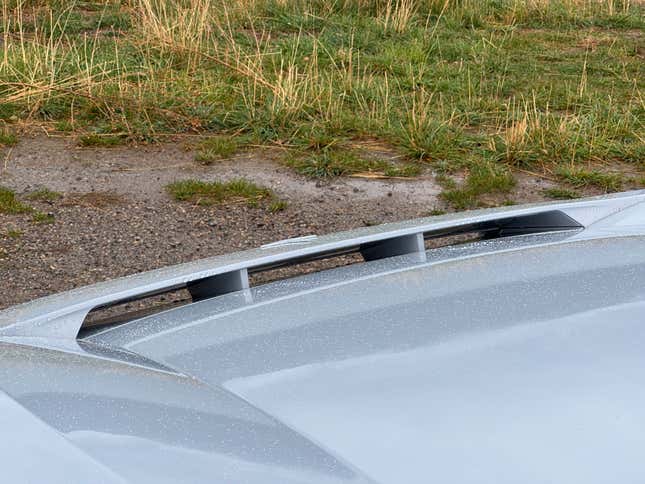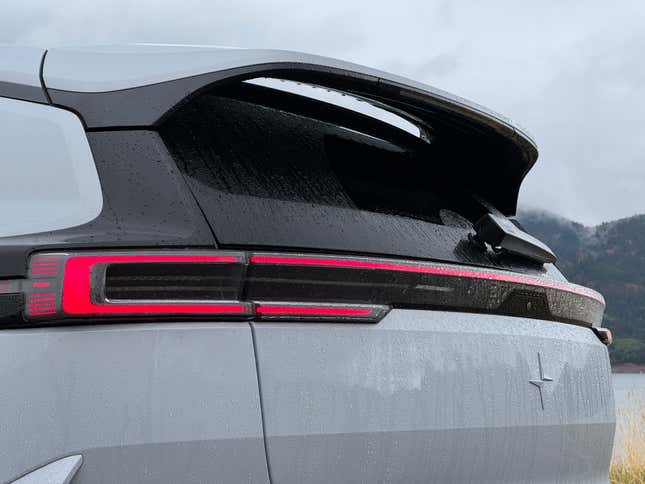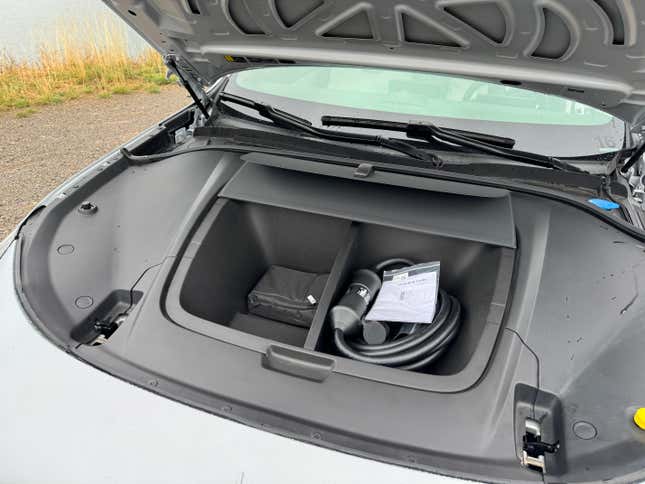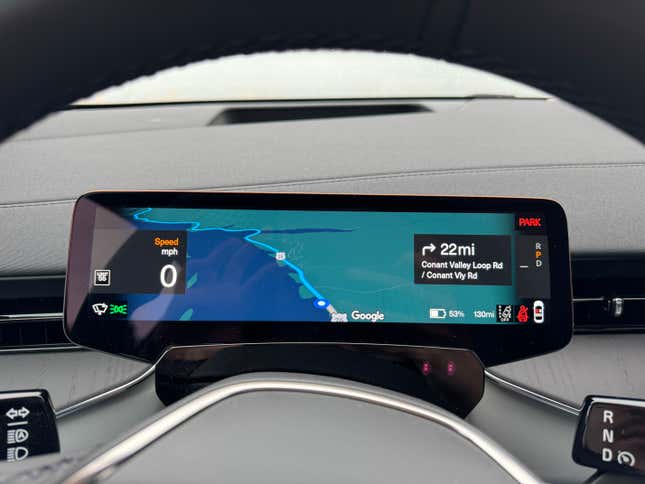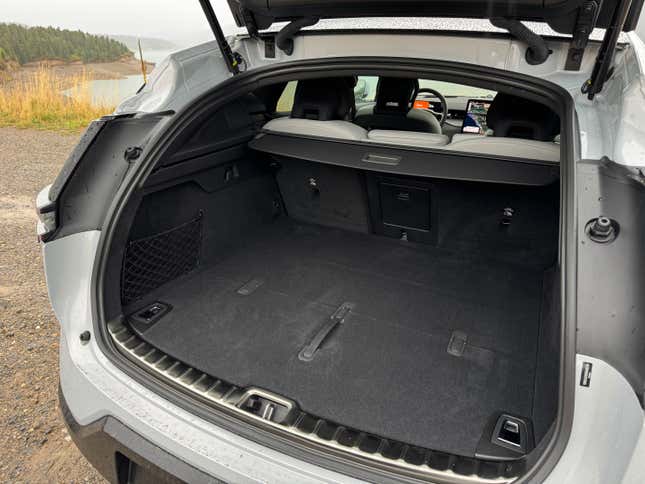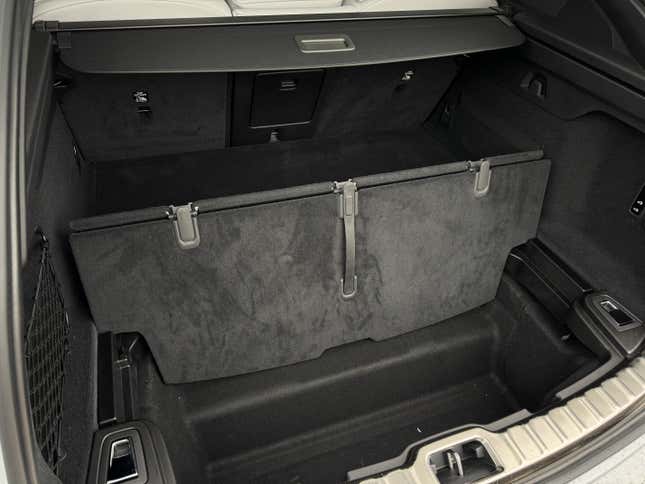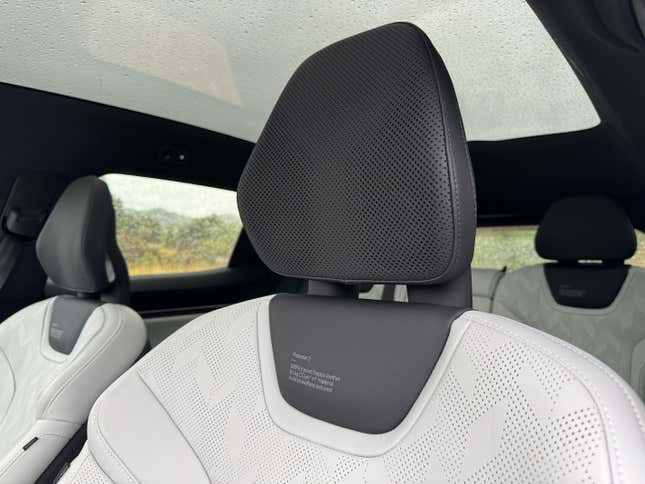In This Story
Staggered-width wheels wearing summer performance tires. A front aero wing and pass-through rear spoiler. Prominent rear haunches and wide flared fenders. A nicely tapering roofline. Gold Brembo brake calipers. A badge that says how much horsepower it makes. All attributes that would typically be associated with a sports car, and yet I’m describing an electric SUV from a Volvo spinoff brand. It’s the Polestar 3, the third model, largest offering and first true crossover from the Chinese-owned Swedish company.
Sadly, it was raining for nearly all of our drive day, where we took fantastic mountain roads from Jackson, Wyoming through Swan Valley, Idaho to Alpine, WY, and back again. We got to sample two different versions of the Polestar 3, both of which wore 22-inch wheels with Pirelli P Zero summer tires. While the cars felt totally surefooted even when the rain turned into snow and slush as we went back down the mountain into Jackson, I didn’t get to really feel out the Polestar 3’s dynamic capabilities, a shame as the 3 is being pitched as a performance-focused competitor to crossovers like the Porsche Cayenne. Still, it was a lovely drive in what I found to be a wonderful new entry into the luxury SUV segment, one that stands out especially if you’re a design lover.
Full disclosure: Polestar flew me out to Jackson, Wyoming, put me up in a nice hotel and fed me delicious food so I could drive the Polestar 3. The weather on our drive day sucked, but drinking Cowgirl Cosmos at the Million Dollar Cowboy Bar that night made up for it.
When I first saw the Polestar 3 at the global reveal in the fall of 2022 I was pretty blown away. To me it’s a spectacular design regardless of segment, not just for an SUV. The 3 is the first Polestar model not still tied to Volvo’s design language, and though there are definitely still some throughlines, it has a distinct identity. A Polestar spokesperson described how the 3 was designed to appeal to all sorts of “humanoids,” meaning a robot or alien could find it as sexy as humans will. (Yes, really.) At 193 inches long and 64 inches tall the Polestar is about an inch shorter in both length and height than a Cayenne, and its 117.5-inch wheelbase is 3.5 inches longer. The Polestar’s stance is fantastic from every angle, especially with the 22s, and I especially love the shape of the floating D-pillar and how it informs the outline of the rear window and taillights.
I think the interior is stunning, too. The familial resemblance with its Volvo EX90 sibling is a bit more obvious inside, as the Polestar uses the same 14.5-inch central touchscreen and 9-inch digital gauge cluster, and other bits like the center console and window switches are also shared. There are more than enough unique touches and thoughtful details to make the Polestar feel distinct, like upper door sections and speaker grilles that echo the shape of the exterior side skirts. Much of the interior materials are recycled, with surfaces using recycled polyester textile and flax fiber, carpets made from used fishing nets and headliner made from water bottles.
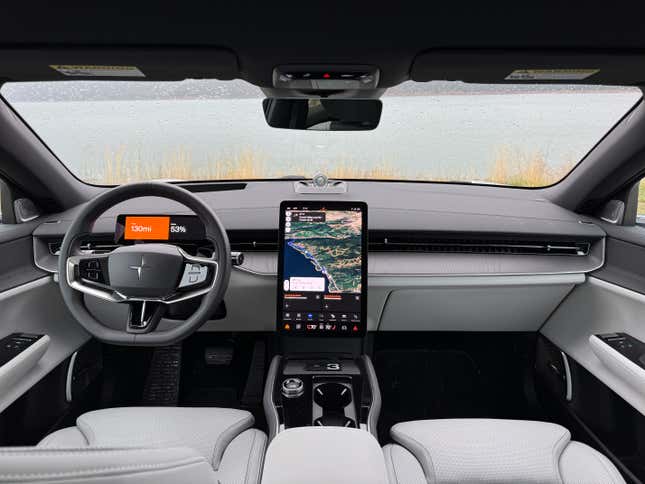
The Polestar 3 shares its SPA 2 platform, dual electric motors and 400-volt, 111-kWh battery pack with the EX90, but with a good bit more power. As standard the 3’s dual-motor all-wheel-drive setup puts out 489 horsepower and 620 pound-feet of torque, 87 hp and 52 lb-ft more than a base EX90. Add the $6,000 Performance pack and output is upped to 517 hp and 671 lb-ft, 7 hp more than the EX90 Performance. The normal 3 will hit 60 mph in 4.8 seconds while the Performance version takes just 4.5 seconds, and both are limited to 130 mph. (That makes it just a tenth off a V8 Cayenne GTS.) Driving the Performance version of the Polestar 3 before the standard one revealed barely a difference in real-world speed; both have brisk acceleration that feels more eager than in the EX90, with quick responses that are sporty enough.
If you want the longest range, you’ll need to go for the standard Long Range model, which the EPA rates at 315 miles with the available 21-inch wheels, or 310 miles with the base 20s and 287 miles with the optional 22s. Choose the Performance pack, and the EPA range goes down to 279 miles. That puts the Polestar 3 in the heart of the segment, and its 250-kW fast-charging capability is pretty good too, offering 30-minute charge times to go from 10 to 80 percent. The displayed range felt pretty accurate throughout the cold-weather drives, with a Performance model showing 260 miles of range with a 96-percent charge and a Long Range saying 130 miles at 53 percent. A standard heat pump and climate preconditioning will help in wintery climates, too.
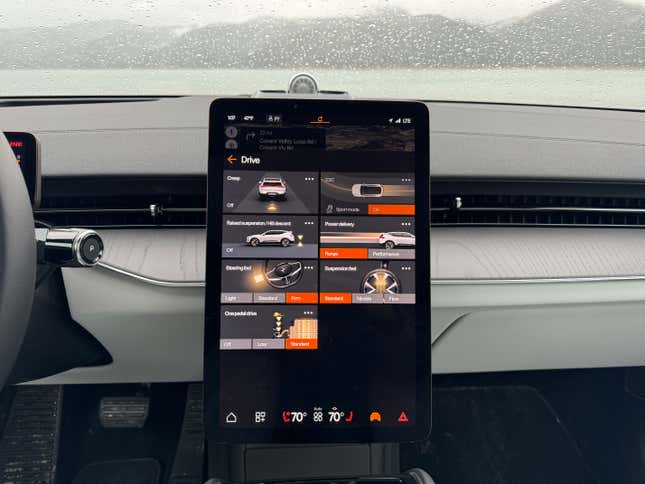
There are three settings for the steering firmness (the heaviest is my favorite and the lightest is too light) and three settings for the dual-chamber air suspension’s semi-active dampers (I liked the middle Nimble setting the most). Regardless of configuration the Polestar 3 rides very nicely, even on these huge wheels, and it corners flat with precise steering. The 3 has a perfect 50:50 weight distribution, and Polestar says its center of gravity is even lower than the Polestar 1’s. You can choose between Range or Performance drive modes, plus you can put the stability control into a Sport mode.
The 3’s electric rear axle has a trick torque-vectoring dual-clutch system that can accelerate the outside rear wheel to turn more sharply, instead of normal simulated torque vectoring that brakes the inner wheel. It can also disconnect the rear motor while cruising on the freeway or under low loads for improved efficiency. Thanks to the weather I didn’t really get to feel out its capabilities, but it was a satisfying car to drive through the canyons nonetheless.
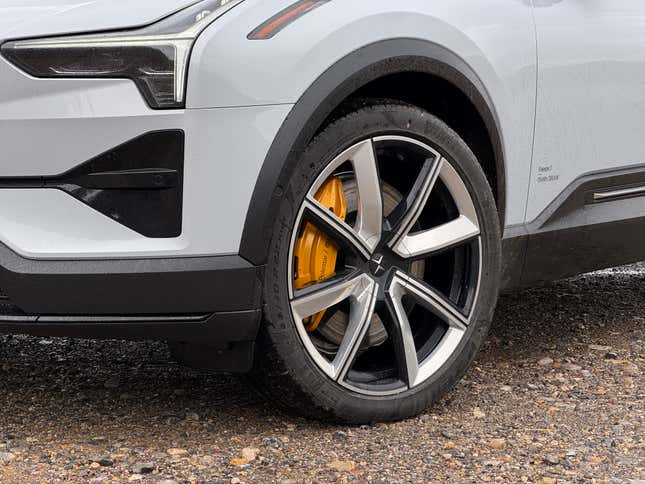
You can also choose between three settings for the regenerative braking, the strongest of which offers true one-pedal driving that is really easy to use smoothly, whether you’re driving in the city or going quickly on a good road. And if you need them, every Polestar 3 has Brembo brakes with 4-piston calipers and 15.7-inch discs in the front and single-piston calipers with 15.4-inch discs in the back.
That Performance pack also adds unique 22-inch wheels that I don’t think look as cool as the optional 22s on the standard 3; both have the same size tires at 265/40 up front and 295/35 at the back. (20-inch wheels come standard, while staggered-width 21s are optional.) Aside from the extra power and wheels, the only other items are specific chassis tuning, tweaked torque distribution, and gold accents for the brakes, valve stem covers and seat belts. It’s probably not worth the upcharge unless you really need those extra few tenths.
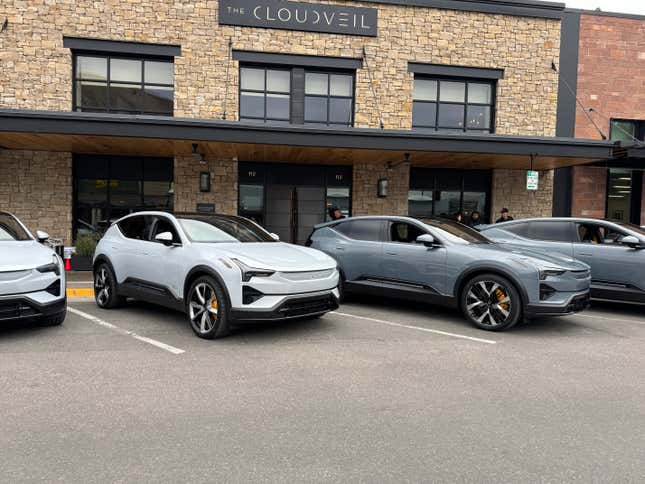
An upside to the gross weather was being able to spend more time taking in the Polestar 3’s cabin and user interface. While not as quiet as the Rolls-Royce–like EX90, the Polestar 3 is extremely quiet inside, with the wide tires being the only real producer of noise that reaches the cabin. Chalk some of the quietness up to the Polestar’s 0.29 coefficient of drag, flush window glazing and clever aero solutions. Despite the small rear window and thick D-pillar visibility isn’t too bad out the back, and the view out front is great.
As usual, Polestar has some of the best seats in the business, especially with the $5,500 Nappa leather upgrade that adds ventilation and a fantastic massage function. It looks best in the Zinc color, as that light gray is also found on the lower dashboard and door panels. Polestar also offers wool seats for $1,100, though they only come in black, which is disappointing. With the available 25-speaker Bowers & Wilkins sound system you get two speakers in each front seat headrest, which work with the active noise canceling and Dolby Atmos spatial audio tech to give you a true surround-sound experience.
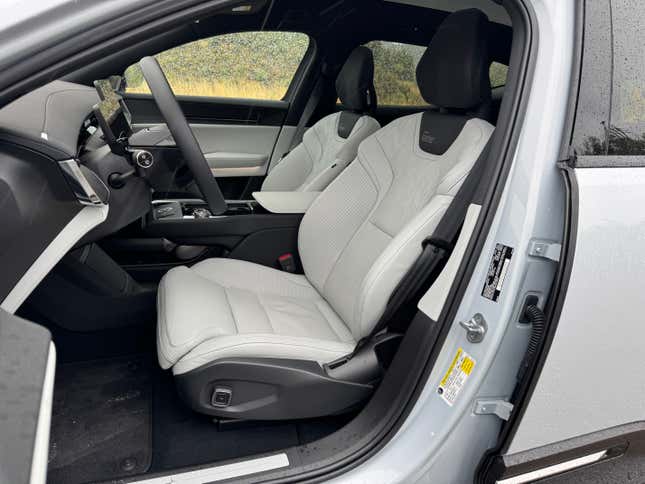
There’s a ton of room in the back seat, and the standard panoramic sunroof and sloping roofline don’t seem to cut into the headroom. With the rear seats up the cargo area has 21.1 cubic feet of storage space and an additional 3.2 cubic feet under the floor, and in some trims the false floor can be partially folded and placed into built-in notches to double as a bag holder and cargo divider. There’s also a 1.1-cubic-foot covered storage area in the frunk.
During the drive I got in a spirited discussion with my drive partner Mack Hogan, former Jalopnik intern and current InsideEVs deputy editor, about the Polestar 3’s almost completely buttonless user interface. He really didn’t like how it took at least two taps of the screen to activate the front defroster as the weather got bad; I don’t mind that at all, as hitting the two touchscreen buttons won’t require you to really move your hand or look away for more than a split second, no more annoying than an actual button would be. I don’t care at all that your mirrors and steering wheel are adjusted using the screen and steering wheel buttons, because if I owned the car, I’d almost never touch them.
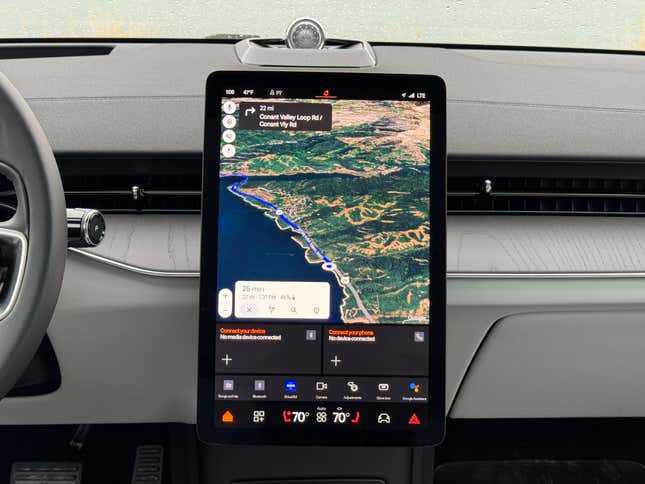
The steering wheel controls are adaptive, so up/down and left/right buttons can control different functions depending on what thing you’ve toggled on, like controlling the side mirror adjustments or your adaptive cruise control follow distance. But on our drive the buttons are very limited in scope — for instance, they can’t control audio volume or skip tracks, which Polestar says will come soon with an over-the-air update. OK, yeah, that’s pretty ridiculous. At least the volume knob on the center console is prominent and satisfying to spin.
I find the Polestar’s Android Automotive–based infotainment system to be great to look at and easy to use, though, with an excellent font and graphics and menus that are well laid out. Most of the home screen is taken up by the excellent native Google Maps, and the map can also be projected in the driver display with additional directions in the available head-up display. Beneath the map are configurable widgets that show recently played media, and below that are a row of modular buttons that change based on recently used apps or the driving situation. At the base of the screen are climate controls that are always present, which open up small pop-ups or the full climate menu.
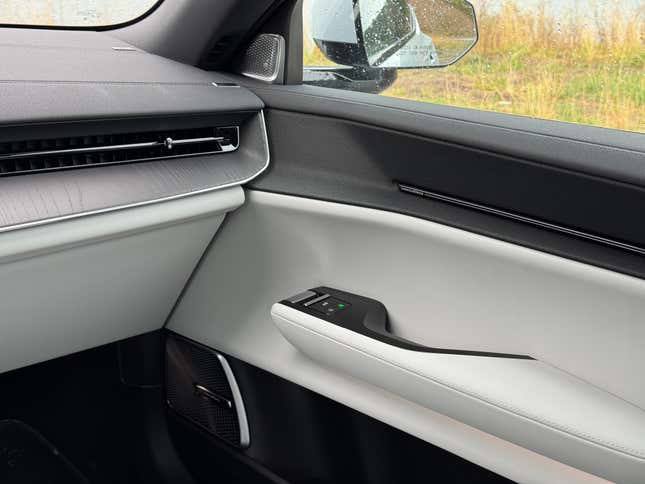
This is actual minimalism done right, a more authentic design-forward approach than the minimalist-to-a-fault cabins of Teslas. The lack of buttons and switches opened Polestars’ designers up to create a really calm, warm space that still has enough detailing to not feel sparse or boring. As a whole the Polestar 3’s design feels authentically Scandinavian, reminding me of modern Swedish architecture and industrial design. It would feel at home on display at Copenhagen fashion week, used in an Ikea ad spread, or being driven by a character in a Danish crime show. The Polestar 3 is just plain cool.
Last month Polestar began production of the 3 at the Charleston, South Carolina factory that also builds the Volvo EX90 (and used to build the Volvo S60 sedan), but a small amount of China-built 3s were brought over to the U.S. before the recent tariffs were enacted, so those will be the first to reach customer hands. The first Polestar 3s will be the Launch Edition spec, which starts at $80,300 including destination, $990 less than an EX90. Identifiable by its gold brakes, the Launch Edition comes standard with the Plus package that costs $5,500 on the non-LE models, which adds 21-inch wheels, the B&W sound system, a head-up display, soft-close doors, that fancy cargo floor, heated wipers, a cabin air-quality sensor, an infrared windshield, power adjustment and memory for the steering column, a heated steering wheel and heated rear seats.
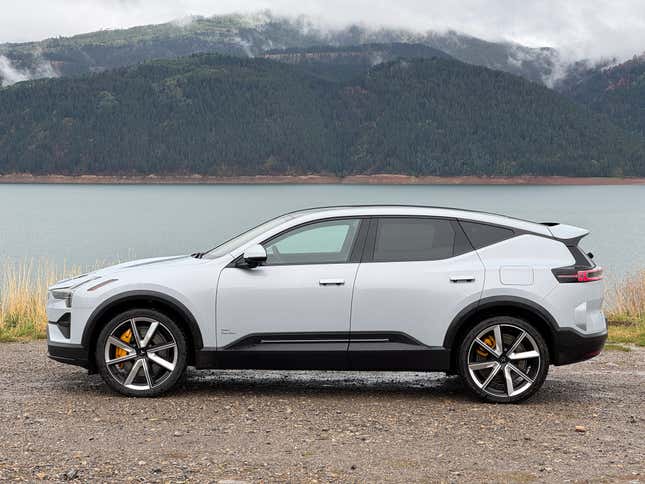
For now every Polestar 3 comes with the Pilot pack, though eventually that will probably be optional as well, bringing the car’s base price below the current $74,800 for the standard Long Range. The Pilot pack gets you a 360-degree camera system that’s fine but not amazing, front and rear parking sensors with parking assist, and the Pilot Assist system that includes adaptive cruise control with steering assist that works at up to 93 mph, plus automatic lane changes. Later in 2025, you’ll be able to spend $5,000 on an upgraded Pilot pack that adds LiDAR from Luminar, more cameras and an additional Nvidia computer for more advanced future driver-assist tech, including hands-free operation.
Also standard on every Polestar 3 are four USB-C ports and a wireless charger, 8-way electrically adjustable heated front seats, three-zone automatic climate control, full LED lights with welcome sequences, a power tailgate with hands-free opening, heated frameless mirrors, rain-sensing wipers and a 10-speaker sound system. Other standard safety features include automated emergency braking with cyclist and pedestrian detection, blind-spot monitoring, a driver-monitoring system with eye tracking, lane-departure warning, lane-keeping assist, traffic sign recognition, post-impact braking, rear collision warning and braking, an occupant detection system and more. And unlike the EX90, which relies on a digital key that didn’t work well, the Polestar comes with a keycard and a traditional keyfob in addition to the digital option.
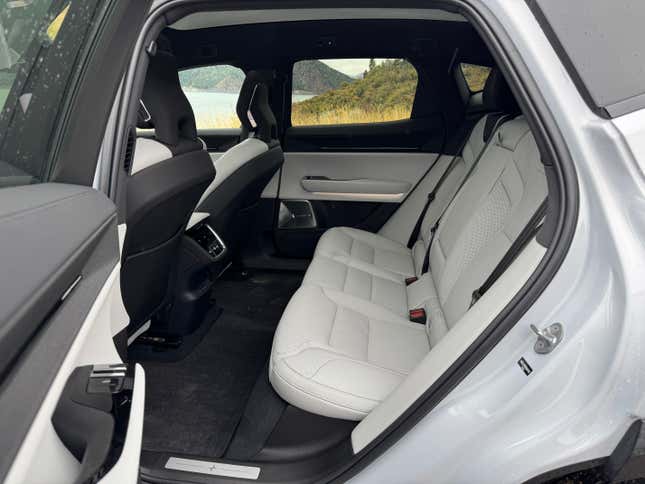
That pricing and feature set put the Polestar 3 in a pretty competitive spot. The fabulous but less sporty BMW iX, which is similar in terms of size, range and performance, starts at $88,425 before options. A dual-motor Mercedes-Benz EQE500 SUV starts beyond $90k, and while the larger Rivian R1S costs about the same as the Polestar to start, its price (and performance) quickly increase if you want anything but the base trim. Then there’s the Porsche Cayenne, which starts in the six figures if you want a V8. Against the Volvo EX90 I think the Polestar comes out as the better buy too, though the Volvo does have a third row of seats.
Polestar expects the 3 will be its biggest seller, though the company isn’t publicly making any projections on how it needs to do to be considered a success. The South Carolina plant can make up to 150,000 cars per year, and the EX90 is likely to be the volume seller, especially as Volvo has actual dealerships to sell its cars out of, versus Polestar relying on Tesla-like showrooms and online sales. The Polestar 3 might be a hard sell to some, as it doesn’t have any real headline-grabbing stats or features, and surely its interface will put off tech-averse buyers. But for those who want a performance-leaning electric SUV that puts design first, the Polestar 3 could easily win you over.
